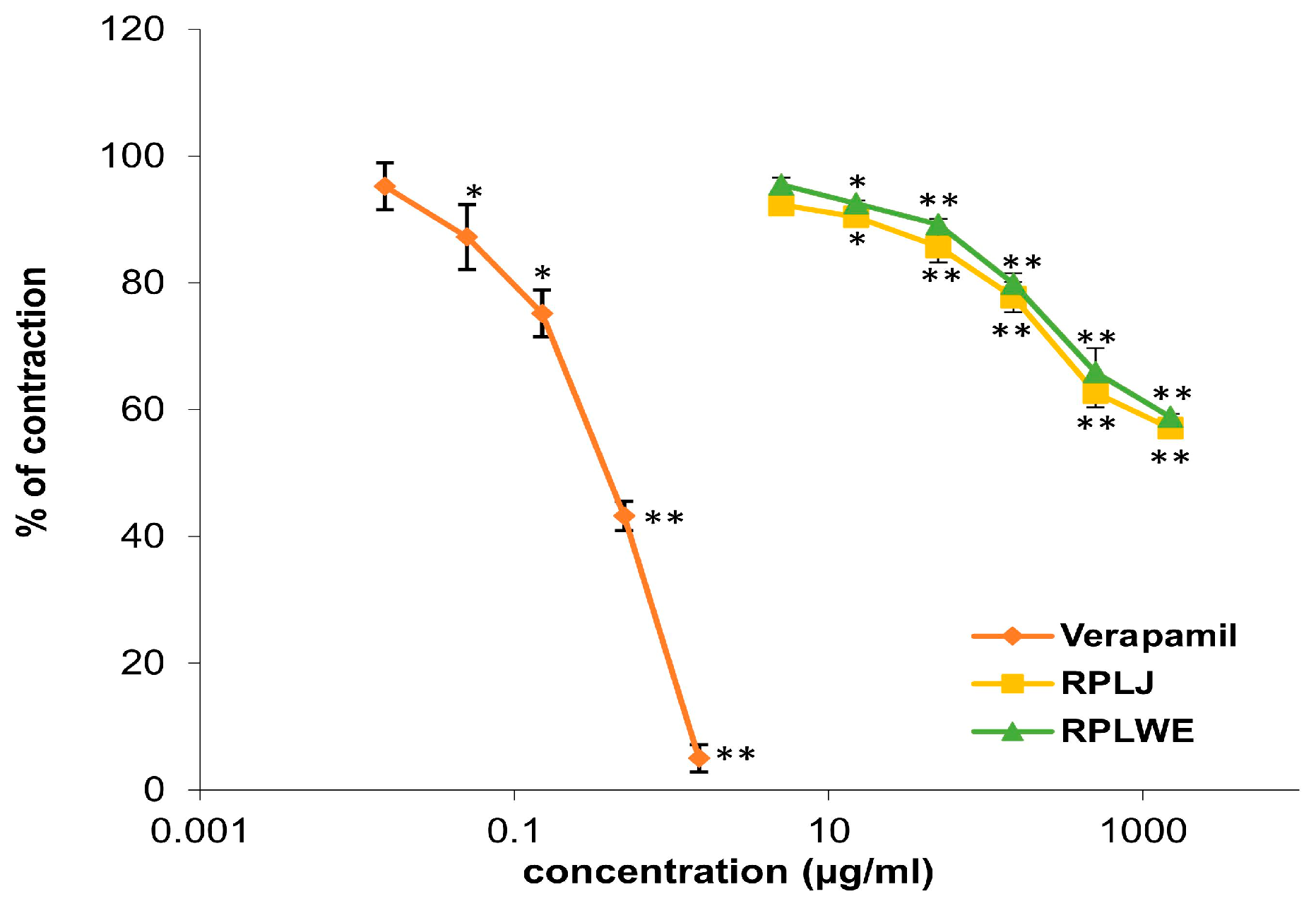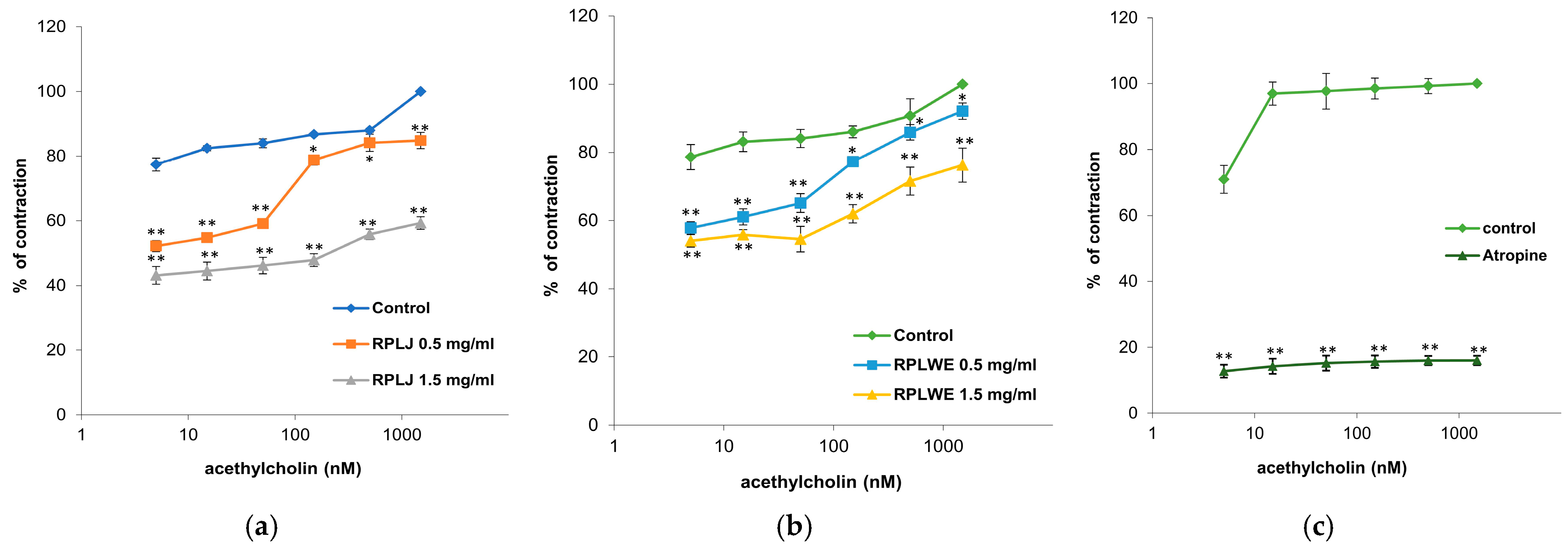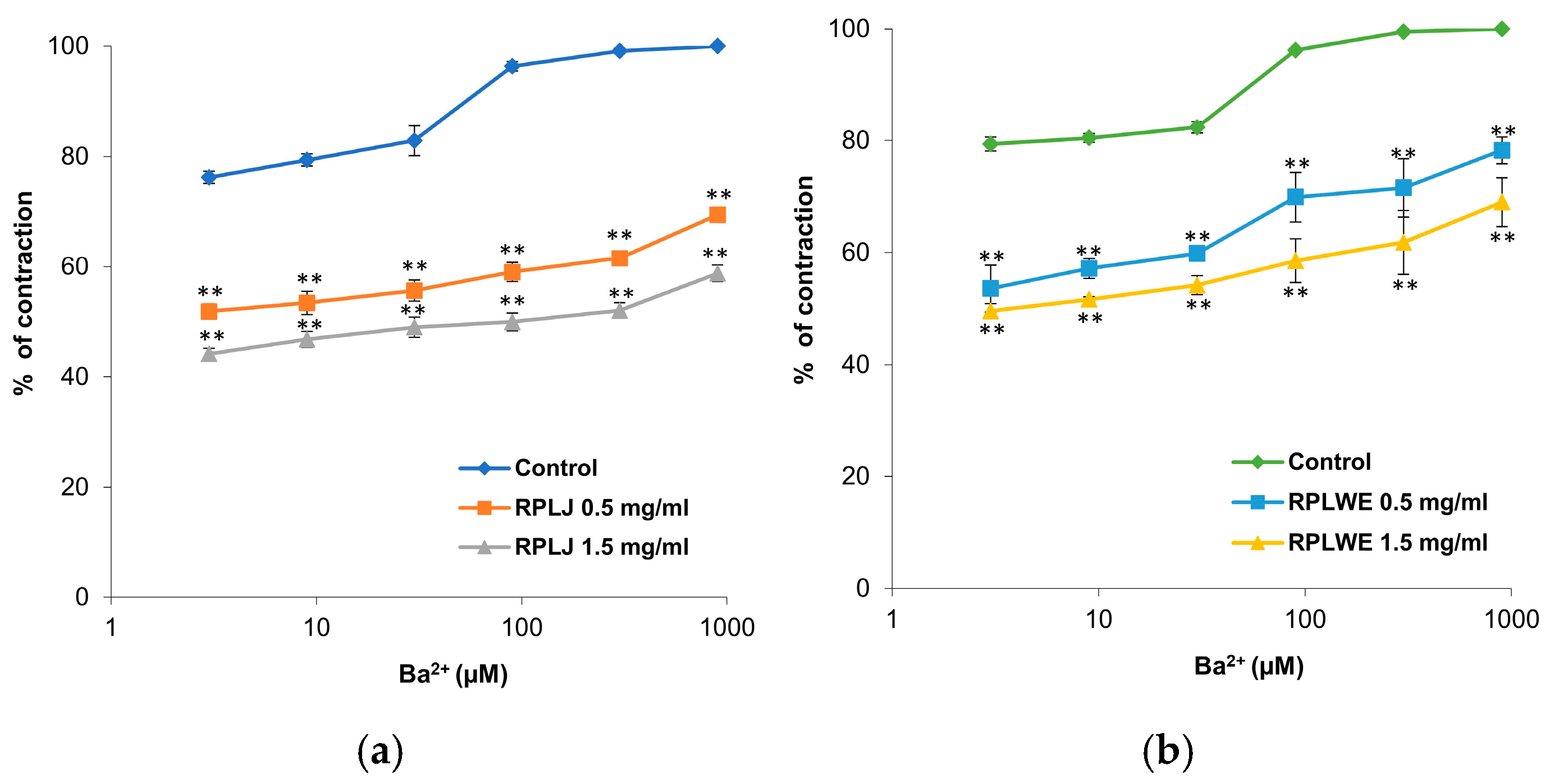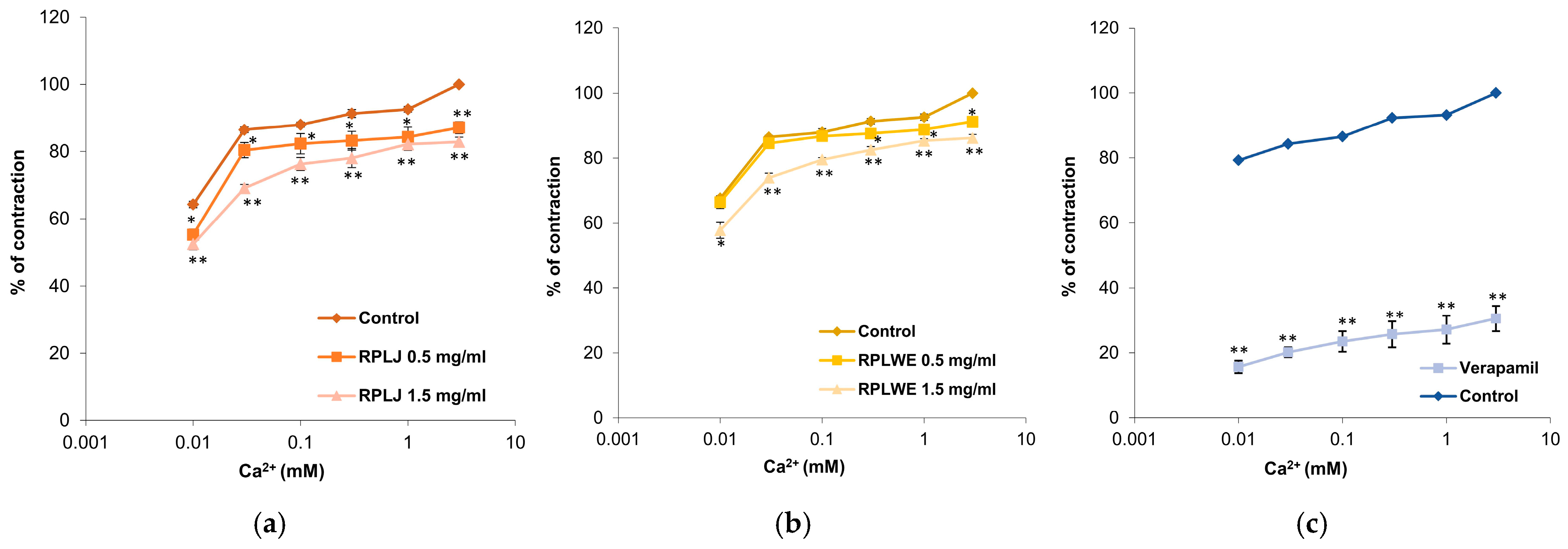Red Currant (Ribes rubrum L.) Fruit Waste Extract and Juice as Potential Spasmolytic Agents
Abstract
1. Introduction
2. Results
2.1. Chemical Content (Total Phenols, Total Tannins, Ascorbic Acid, Anthocyanin, and Flavonol Content) of RPLJ and RPLWE
2.2. Antioxidant Activity
2.3. Spasmolytic Activity
2.3.1. Effects of RPLJ, RPLWE, and C3G on Spontaneous Contractions of the Isolated Rat Ileum
2.3.2. Effects of RPLJ and RPLWE on KCl-Induced Contraction of Rat Ileum
2.3.3. Effects of RPLJ and RPLWE on Histamine-Induced Ileum Contraction
2.3.4. Effects of RPLJ and RPLWE on Acetylcholine (ACh)-Induced Contraction of Rat Ileum
2.3.5. Effect of RPLJ and RPLWE on BaCl2-Induced Contraction of Rat Ileum
2.3.6. Effects of RPLJ and RPLWE on CaCl2-Induced Contraction of Rat Ileum
3. Discussion
4. Materials and Methods
4.1. Plant Material and Sample Preparation
4.2. Determination of Total Polyphenols
4.3. Determination of Total Tannins
4.4. Determination of ACs
Chromatographic Conditions
4.5. Ascorbic Acid Determination (AsA)
Chromatographic Conditions
4.6. Determination of Flavonol Content
Chromatographic Conditions
4.7. 2,2-Diphenyl-1-picrylhydrazyl (DPPH) Radical Scavenging Activity
4.8. β-Carotene Bleaching Method
4.9. Spasmolytic Activity
4.9.1. Experimental Animals
4.9.2. Experimental Design
4.9.3. Examination of the Effect of RPLJ, RPLWE, and C3G on Spontaneous Contractions of the Rat Ileum
4.9.4. Examination of the Effect of RPLJ and RPLWE on KCl-Induced Contraction of the Rat Ileum
4.9.5. Examination of the Effect of RPLJ and RPLWE on CaCl2-Induced Contraction of the Rat Ileum
4.9.6. Examination of the Effect of RPLJ and RPLWE on BaCl2-Induced Contraction of the Rat Ileum
4.9.7. Examination of the Effect of RPLJ and RPLWE on ACh-Induced Contraction of the Rat Ileum
4.9.8. Examination of the Effect of RPLJ and RPLWE on Histamine-InducedContraction of the Rat Ileum
4.10. Statistical Analysis
5. Conclusions
Author Contributions
Funding
Institutional Review Board Statement
Data Availability Statement
Acknowledgments
Conflicts of Interest
References
- Wang, Y.; Huang, Y.; Chase, R.C.; Li, T.; Ramai, D.; Li, S.; Huang, X.; Antwi, S.O.; Keaveny, A.P.; Pang, M. Global Burden of Digestive Diseases: A Systematic Analysis of the Global Burden of Diseases Study, 1990 to 2019. Gastroenterology 2023, 165, 773–783. [Google Scholar] [CrossRef]
- World Health Organization. Available online: https://www.who.int/tools/elena/interventions/fruit-vegetables-ncds#:~:text=WHO%20Recommendations,the%20risk%20of%20certain%20NCDs (accessed on 5 June 2024).
- International Foundation for Gastrointestinal Disorders. Available online: https://iffgd.org/gi-disorders/motility-disorders/ (accessed on 12 June 2024).
- Drossman, D.A. Functional gastrointestinal disorders: History, pathophysiology, clinical features and Rome IV. Gastroenterology 2016, 150, 1262–1279. [Google Scholar] [CrossRef] [PubMed]
- Veberic, R.; Slatnar, A.; Bizjak, J.; Stampar, F.; Mikulic-Petkovsek, M. Anthocyanin composition of different wild and cultivated berry species. LWT-Food Sci. Technol. 2015, 60, 509–517. [Google Scholar] [CrossRef]
- Mikulic-Petkovsek, M.; Rescic, J.; Schmitzer, V.; Stampar, F.; Slatnar, A.; Koron, D.; Veberic, R. Changes in fruit quality parameters of four Ribes species during ripening. Food Chem. 2015, 173, 363–374. [Google Scholar] [CrossRef]
- Mikulic-Petkovsek, M.; Koron, D.; Veberic, R. Quality parameters of currant berries from three different cluster positions. Sci. Hortic. 2016, 210, 188–196. [Google Scholar] [CrossRef]
- Pikunova, A.V.; Martirosian, E.V.; Kniazev, S.D.; Ryzhova, N.N. Application of the RAPD-analysis for the study of genetic polymorphism and phylogenetic relationships in the Ribes L. genus. Russ. J. Genet. Appl. Res. 2012, 2, 141–151. [Google Scholar] [CrossRef]
- Rotundo, A.; Bounous, G.; Benvenuti, S.; Vampa, G.; Melegari, M.; Soragni, F. Quality and yield of Ribes and Rubus cultivars grown in Southern Italy hilly location. Phytother. Res. 1998, 12, 135–137. [Google Scholar] [CrossRef]
- Milivojevic, J.; Slatnar, A.; Mikulic-Petkovsek, M.; Stampar, F.; Nikolic, M.; Veberic, R. The influence of early yield on the accumulation of major taste and health-related compounds in black and red currant cultivars (Ribes spp.). J. Agric. Food Chem. 2012, 60, 2682–2691. [Google Scholar] [CrossRef] [PubMed]
- Djordjevic, B.; Savikin, K.; Zdunic, G.; Janković, T.; Vulić, T.; Oparnica, C.; Radivojević, D. Biochemical Properties of Red Currant Varieties in Relation to Storage. Plant Foods Hum. Nutr. 2010, 65, 326–332. [Google Scholar] [CrossRef]
- Benvenuti, S.; Pellati, F.; Melegari, M.; Bertelli, D. Polyphenols, anthocyanins, ascorbic acid, and radical scavenging activity of Rubus, Ribes, and Aronia. J. Food Sci. 2004, 69, C164–C169. [Google Scholar] [CrossRef]
- Frum, A.; Georgescu, C.; Gligor, F.; Tita, O. Identification and Quantification of Phenolic Compounds from Red Currant (Ribes rubrum L.) and Raspberries (Rubus idaeus L.). Int. J. Pharmacol. Phytochem. Ethnomed. 2017, 6, 30–37. [Google Scholar] [CrossRef]
- Pirjo, H.M.; Jarkko, H.; Saila, K.; Pihlava, J.-M.; Veteläinen, M. High variability in flavonoid contents and composition between different North-European currant (Ribes spp.) varieties. Food Chem. 2016, 204, 14–20. [Google Scholar] [CrossRef]
- Arts, I.C.W.; Hollman, P.C.H. Polyphenols and disease risk in epidemiologic studies. Am. J. Clin. Nutr. 2005, 81, 317S–325S. [Google Scholar] [CrossRef] [PubMed]
- Du, G.; Sun, L.; Zhao, R.; Du, L.; Song, J.; Zhang, L.; He, G.; Zhang, Y.; Zhang, J. Polyphenols: Potential source of drugs for the treatment of ischaemic heart disease. Pharmacol. Ther. 2016, 162, 23–34. [Google Scholar] [CrossRef] [PubMed]
- Rees, A.; Dodd, G.F.; Spencer, J.P. The effects of flavonoids on cardiovascular health: A review of human intervention trials and implications for cerebrovascular function. Nutrients 2018, 10, 1852. [Google Scholar] [CrossRef] [PubMed]
- Knekt, P.; Jarvinen, R.; Seppanen, R.; Hellövaara, M.; Teppo, L.; Pukkala, E.; Aromaa, A. Dietary flavonoids and the risk of lung cancer and other malignant neoplasms. Am. J. Epidemiol. 1997, 146, 223–230. [Google Scholar] [CrossRef]
- Dey, T.B.; Chakraborty, S.; Jain, K.K.; Sharma, A.; Kuhad, R.C. Antioxidant phenolics and their microbial production by submerged and solid state fermentation process: A review. Trends Food Sci. Technol. 2016, 53, 60–74. [Google Scholar] [CrossRef]
- Tsuda, T.; Horio, F.; Uchida, K.; Aoki, H.; Osawa, T. Dietary Cyanidin 3-O-β-D-Glucoside-Rich Purple Corn Color Prevents Obesity and Ameliorates Hyperglycemia in Mice. J. Nutr. 2003, 133, 2125–2130. [Google Scholar] [CrossRef] [PubMed]
- Wojdyło, A.; Oszmiański, J.; Milczarek, M.; Wietrzyk, J. Phenolic profile, antioxidant and antiproliferative activity of black and red currants (Ribes spp.) from organic and conventional cultivation. Int. J. Food Sci. Technol. 2013, 48, 715–726. [Google Scholar] [CrossRef]
- Folmer, F.; Basavaraju, U.; Jaspars, M.; Hold, G.; El-Omar, E.; Dicato, M.; Diederich, M. Anticancer effects of bioactive berry compounds. Phytochem. Rev. 2014, 13, 295–322. [Google Scholar] [CrossRef]
- Wang, B.; Tang, X.; Mao, B.; Zhang, Q.; Tian, F.; Zhao, J.; Chen, W.; Cui, S. Effects of in vitro fecal fermentation on the metabolism and antioxidant properties of cyanidin-3-O-glucoside. Food Chem. 2024, 431, 137132. [Google Scholar] [CrossRef] [PubMed]
- Panritdum, P.; Muangnoi, C.; Tuntipopipat, S.; Charoenkiatkul, S.; Sukprasansap, M. Cleistocalyx nervosum var. paniala berry extract and cyanidin-3-glucoside inhibit hepatotoxicity and apoptosis. Food Sci. Nutr. 2024, 12, 2947–2962. [Google Scholar] [CrossRef]
- Cvetkovic, M.; Mihajilov-Krstev, T.; Šavikin, K.; Zdunić, G.; Kitić, D.; Randjelović, M.; Stojanović, D.; Milutinović, M.; Ilić, D.; Miladinović, B. Antimicrobial activity assessment on lyophilized juice and waste extract of red currant variety Redpoll. Acta Medica Median. 2023, 62, 38–44. [Google Scholar] [CrossRef]
- Zhang, J.; Wu, J.; Liu, F.; Tong, L.; Chen, Z.; Chen, J.; He, H.; Xu, R.; Ma, Y.; Huang, C. Neuroprotective effects of anthocyanins and its major component cyanidin-3-O-glucoside (C3G) in the central nervous system: An outlined review. Eur. J. Pharmacol. 2019, 858, 172500. [Google Scholar] [CrossRef] [PubMed]
- Frountzas, M.; Karanikki, E.; Toutouza, O.; Sotirakis, D.; Schizas, D.; Theofilis, P.; Tousoulis, D.; Toutouzas, K.G. Exploring the Impact of Cyanidin-3-Glucoside on Inflammatory Bowel Diseases: Investigating New Mechanisms for Emerging Interventions. Int. J. Mol. Sci. 2023, 24, 9399. [Google Scholar] [CrossRef] [PubMed]
- Baek, H.; Sanjay, P.; Park, M.; Lee, H.-J. Cyanidin-3-O-glucoside protects the brain and improves cognitive function in APPswe/PS1ΔE9 transgenic mice model. J. Neuroinflamm. 2023, 20, 268. [Google Scholar] [CrossRef]
- Ren, J.; Lu, Y.; Qian, Y.; Chen, B.; Wu, T.; Ji, G. Recent progress regarding kaempferol for the treatment of various diseases. Exp. Ther. Med. 2019, 18, 2576–2759. [Google Scholar] [CrossRef] [PubMed]
- Imran, M.; Rauf, A.; Shah, Z.A.; Saeed, F.; Imran, A.; Arshad, M.U.; Ahmad, B.; Bawazeer, S.; Atif, M.; Peters, D.G.; et al. Chemo-preventive and therapeutic effect of the dietary flavonoid kaempferol: A comprehensive review. Phytother. Res. 2019, 33, 263–275. [Google Scholar] [CrossRef]
- Larson, A.J.; Symons, J.D.; Jalili, T. Quercetin: A Treatment for Hypertension?—A Review of Efficacy and Mechanisms. Pharmaceuticals 2010, 3, 237–250. [Google Scholar] [CrossRef] [PubMed]
- Macander, P.J. Flavonoids affect acetylcholine, prostaglandin E and antigen mediated smooth muscle contraction. Prog. Clin. Biol. Res. 1986, 213, 489–492. [Google Scholar] [PubMed]
- Capasso, F.; Pinto, A.; Mascolo, N.; Autore, G.; Franco, M.P. Effects of flavonoids on PAG2- and LTD-induced contractions on the guinea-pig isolated ileum. Pharmacol. Res. Commun. 1988, 20, 201–202. [Google Scholar] [CrossRef]
- Talcott, S.T. Chemical components of berry fruits. In Berry Fruits: Value-Added Products for Health Promotion, 1st ed.; Zhao, Y., Ed.; Routledge: Oxfordshire, UK, 2007; pp. 51–72. [Google Scholar]
- Gavrilova, V.; Kajd, Z.M.; Gjamovski, V.; Stefova, M. Separation, characterization and quantification of phenolic compounds in blueberries and red and black currants by HPLC–DAD–ESI–MS. J. Agric. Food Chem. 2011, 59, 4009–4018. [Google Scholar] [CrossRef]
- Plessi, M.; Bertelli, D.; Albasini, A. Distribution of metals and phenolic compounds as a criterion to evaluate variety of berries and related jams. Food Chem. 2007, 100, 419–427. [Google Scholar] [CrossRef]
- Wu, X.; Gu, L.; Prior, R.L.; McKay, S. Characterization of anthocyanins and proanthocyanidins in some cultivars of Ribes, Aronia, and Sambucus and their antioxidant capacity. J. Agric. Food Chem. 2004, 52, 7846–7856. [Google Scholar] [CrossRef]
- Konic, R.A.; Savikin, K.; Zdunic, G.; Janković, T.; Juranić, Z.; Menković, N.; Stanković, I. Biological activity and chemical composition of different berry juices. Food Chem. 2011, 125, 1412–1417. [Google Scholar] [CrossRef]
- Pantelidis, G.E.; Vasilakakis, M.; Manganaris, G.A.; Diamantidis, G.R. Antioxidant capacity, phenol, anthocyanin and ascorbic acid contents in raspberries, blackberries, red currants, gooseberries and Cornelian cherries. Food Chem. 2007, 102, 777–783. [Google Scholar] [CrossRef]
- Nour, V.; Trandafir, I.; Ionica, M.E. Ascorbic acid, anthocyanins, organic acids and mineral content of some black and red currant cultivars. Fruits 2011, 66, 353–362. [Google Scholar] [CrossRef]
- Mikulic-Petkovsek, M.; Stampar, F.; Veberic, R. The influence of organic/integrated production on the content of phenolic compounds in apple leaves and fruits in four different varieties over 2-year period. J. Sci. Food Agric. 2010, 90, 2366–2378. [Google Scholar] [CrossRef]
- Šavikin, K.; Mikulic-Petkovsek, M.; Djordjevic, B.; Zdunić, G.; Janković, T.; Djurović, D.; Veberič, R. Influence of shading net on polyphenol profile and radical scavenging activity in different varieties of black currant berries. Sci. Hortic. 2013, 160, 20–28. [Google Scholar] [CrossRef]
- Boam, T. Anti-androgenic effects of flavonols in prostate cancer. Ecancermedicalscience 2015, 9, 585. [Google Scholar] [CrossRef]
- Cheng, X.Q.; Chen, X.; Hughes, R.A.; Williams, S.J.; Woodman, O.L. Understanding the cardioprotective effects of flavonols: Discovery of relaxant flavonols without antioxidant activity. J. Med. Chem. 2008, 51, 1874–1884. [Google Scholar] [CrossRef]
- Cushnie, T.P.T.; Hamilton, V.E.S.; Chapman, D.G.; Taylor, P.W.; Lamb, A.J. Aggregation of Staphylococcus aureus following treatment with the antibacterial flavonol galangin. J. Appl. Microbiol. 2007, 103, 1562–1567. [Google Scholar] [CrossRef]
- Tewtrakul, S.; Nakamura, N.; Hattori, M.; Fujiwara, T.; Supavita, T. Flavanone and flavonol glycosides from the leaves of Thevetia peruviana and their HIV-1 reverse transcriptase and HIV-1 integrase inhibitory activities. Chem. Pharm. Bull. 2002, 50, 630–635. [Google Scholar] [CrossRef]
- Zamora-Ros, R.; Forouhi, N.G.; Sharp, S.J.; González, C.A.; Buijsse, B.; Guevara, M.; van der Schouw, Y.T.; Amiano, P.; Boeing, H.; Bredsdorff, L.; et al. Dietary intakes of individual flavanols and flavonols are inversely associated with incident type 2 diabetes in European populations. J. Nutr. 2014, 144, 335–343. [Google Scholar] [CrossRef]
- Carrillo-Lopez, M.; Soto-Hernández, R.M.; Zavaleta-Mancera, H.A.; Vilchis-Néstor, A.R. Study of the Performance of the Organic Extracts of Chenopodium Ambrosioides for Ag Nanoparticle Synthesis. J. Nanomater. 2016, 2016, 4714162. [Google Scholar] [CrossRef]
- De Mejía, E.G.; Song, Y.S.; Heck, C.; Ramírez-Mares, M. Yerba Mate Tea (Ilex paraguariensis): Phenolics, Antioxidant Capacity and In Vitro Inhibition of Colon Cancer Cell Proliferation. J. Funct. Foods 2010, 2, 23–34. [Google Scholar] [CrossRef]
- Di Carlo, G.; Mascolo, N.; Izzo, A.A.; Capasso, F.; Autore, G. Effects of quercetin on the gastrointestinal tract in rats and mice. Phytother. Res. 1994, 8, 42–45. [Google Scholar] [CrossRef]
- Modzelewska, B.; Drygalski, K.; Kleszczewski, T.; Chomentowski, A.; Koryciński, K.; Kiełczewska, A.; Pawłuszewicz, P.; Razak Hady, H. Quercetin relaxes human gastric smooth muscles directly through ATP-sensitive potassium channels and not depending on the nitric oxide pathway. Neurogastroenterol. Motil. 2021, 33, e14093. [Google Scholar] [CrossRef] [PubMed]
- Sadraei, H.; Tabesh, S. Relaxant effect of quercetin on rabbit isolated bladder smooth muscles contractions. J. HerbMed Pharmacol. 2021, 10, 61–67. [Google Scholar] [CrossRef]
- Özkal, N.; Atasü, E.; Ertan, R. Some therapeutic effects of flavonoids: Antispasmodic, antihepatotoxic, vasoprotective effects. FABAD J. Pharmacol. Sci. 1996, 22, 155–161. [Google Scholar]
- Santos-Fagundes, D.; Grasa, L.; Gonzalo, S.; Valero, M.S.; Castro, M.; Arruebo, M.P.; Plaza, M.Á.; Murillo, M.D. Different mechanisms of actions of genistein and quercetin on spontaneous contractions of rabbit duodenum. Rev. Esp. Enferm. Dig. 2015, 107, 413–416. [Google Scholar] [CrossRef]
- Miladinović, B.; Branković, S.; Živanović, S.; Kostić, M.; Šavikin, K.; Ðorđević, B.; Stojanović, D.; Milutinović, M.; Kitić, N.; Kitić, D. Flavonols Composition of Ribes nigrum L. Juices and Their Impact on Spasmolytic Activity. J. Berry Res. 2021, 11, 171–186. [Google Scholar] [CrossRef]
- Mori, M.X.; Itsuki, K.; Hase, H.; Sawamura, S.; Kurokawa, T.; Mori, Y.; Inoue, R. Dynamics of receptor-operated Ca2+ currents through TRPC channels controlled via the PI (4,5)P2-PLC signaling pathway. Front. Pharmacol. 2015, 6, 22. [Google Scholar] [CrossRef]
- Mehmood, M.H.; Siddiqi, H.S.; Gilani, A.H. The antidiarrheal and spasmolytic activities of Phyllanthus emblica are mediated through dual blockade of muscarinic receptors and Ca2+ channels. J. Ethnopharmacol. 2011, 133, 856–865. [Google Scholar] [CrossRef] [PubMed]
- Masuzawa, K.; Matsuda, T.; Asano, M. Evidence that pinacidil may promote the opening of ATP-sensitive K+ channels yet inhibit the opening of Ca2+-activated K+ channels in K+-contracted canine mesenteric artery. Br. J. Pharmacol. 1990, 100, 143–149. [Google Scholar] [CrossRef]
- Brankovic, S.V.; Kitic, D.V.; Radenkovic, M.M.; Veljkovic, S.M.; Golubovic, T.D. Calcium blocking activity as a mechanism of the spasmolytic effect the essential oil of Calamintha glandulosa Silic on isolated rat ileum. Gen. Physiol. Biophs 2009, 28, 174–178. [Google Scholar]
- Hemming, J.M.; Guarraci, F.A.; Firth, T.A.; Jennings, L.J.; Nelson, M.T.; Mawe, G.M. Actions of histamine on muscle and ganglia of the guinea pig gallbladder. Am. J. Physiol. Gastrointest. Liver Physiol. 2000, 279, G622–G630. [Google Scholar] [CrossRef]
- Zoli, M.; Pucci, S.; Vilella, A.; Gotti, C. Neuronal and Extraneuronal Nicotinic Acetylcholine Receptors. Curr. Neuropharmacol. 2018, 16, 338–349. [Google Scholar] [CrossRef] [PubMed]
- Sy, G.Y.; Sarr, A.; Dièye, A.M.; Faye, B. Myorelaxant and antispasmodic effects of the aqueous extract of Mitragyna inermis barks on Wistar rat ileum. Fitoterapia 2004, 75, 447–450. [Google Scholar] [CrossRef]
- Liu, S.; Hu, H.Z.; Ren, J.; Gao, C.; Gao, N.; Lin, Z.; Xia, Y.; Wood, J.D. Pre- and postsynaptic inhibition by nociceptin in guinea pig small intestinal myenteric plexus in vitro. Am. J. Physiol. Gastrointest. Liver Physiol. 2001, 281, G237–G246. [Google Scholar] [CrossRef] [PubMed]
- Miladinovic, B.; Brankovic, S.; Kostic, M.; Milutinovic, M.; Kitic, N.; Šavikin, K.; Kitic, D. Antispasmodic effect of black currant (Ribes nigrum L.) juice and its potential use as functional food in gastrointestinal disorders. Med. Princ. Pract. 2018, 27, 179–185. [Google Scholar] [CrossRef] [PubMed]
- Kovac, M. (Ed.) Yugoslavian Pharmacopoeia 2000 (Ph. Jug. V)–Adjusted translation of European Pharmacopoeia 1997 (Ph. Eur. III) Pharmacopoeia, 5th ed.; Federal Institute for Health Protection and Improvement: Belgrade, Serbia, 2001. [Google Scholar]
- Ćujić, N.; Šavikin, K.; Janković, T.; Pljevljakušić, D.; Zdunić, G.; Ibrić, S. Optimization of polyphenols extraction from dried chokeberry using maceration as traditional technique. Food Chem. 2016, 194, 135–142. [Google Scholar] [CrossRef]
- Makkar, H.P.S. (Ed.) Measurement of Total Phenolics and Tannins Using Folin-Ciocalteu Method. In Quantification of Tannins in Tree and Shrub Foliage; Springer: Dordrecht, The Netherlands, 2003; pp. 49–51. [Google Scholar] [CrossRef]
- Cacace, E.J.; Mazza, G. Extraction of anthocyanins and other phenolics from black currants with sulfured water. J. Agric. Food Chem. 2002, 50, 5939–5946. [Google Scholar] [CrossRef]
- Brubacher, G.; Müller-Mulot, W.; Southgate, D.D.T. (Eds.) Vitamin C (Ascorbic and Dehydroascorbic Acids) in Foodstuffs: HPLC Method. In Methods for the Determination of Vitamins in Food; Springer: Dordrecht, The Netherlands, 1985; pp. 66–75. [Google Scholar] [CrossRef]
- Ohta, K.; Harada, K. Studies on the measurement of ascorbic acid and dehydroascorbic acid in tea plants. Nippon Nogeikagaku Kaishi 1996, 70, 873–882. [Google Scholar] [CrossRef]
- Koleva, I.I.; van Beek, T.A.; Linssen, J.P.H.; de Groot, A.; Evstatieva, L.N. Screening of plant extracts for antioxidant activity: A comparative study on three testing methods. Phytochem. Anal. 2002, 13, 8–17. [Google Scholar] [CrossRef] [PubMed]
- Brankovic, S.; Kitic, D.; Radenkovic, M.; Veljkovic, S.; Jankovic, T.; Savikin, K.; Zdunic, G. Spasmolytic activity of the ethanol extract of Sideritis raeseri spp. Raeseri Boiss & Heldr. on the isolated rat ileum contractions. J. Med. Food 2011, 14, 495–498. [Google Scholar] [CrossRef]
- Bigovic, D.; Brankovic, S.; Kitic, D.; Radenkovic, M.; Jankovic, T.; Savikin, K.; Zivanovic, S. Relaxant effect of the ethanol extract of Helichrysum plicatum (Asteraceae) on isolated rat ileum contractions. Molecules 2010, 15, 3391–3401. [Google Scholar] [CrossRef]






| Compounds | Units | RPLJ | RPLWE |
|---|---|---|---|
| TP | mg GAE/g | 1.34 ± 0.07 a | 1.06 ± 0.04 a |
| TT | mg GAE/g | 0.98 ± 0.05 a | 0.76 ± 0.02 a |
| TAsA | mg/100 g | 230.00 ± 0.01 a | 20.00 ± 0.01 b |
| C3R | mg/100 g | 28.34 ± 3.51 a | 8.40 ± 0.78 b |
| C3G | mg/100 g | 155.38 ± 7.34 a | 34.30 ± 4.55 b |
| quercetin | mg/100 g | 14.00 ± 0.76 a | 18.60 ± 0.97 a |
| kaempferol | mg/100 g | 2.20 ± 0.03 a | 3.50 ± 0.24 a |
| p-coumaric acid | mg/100 g | n.d a | 82.60 ± 4.45 b |
| Sample | DPPH (mg/mL) | β-Carotene (mg/mL) |
|---|---|---|
| RPLJ | 0.98 ± 0.04 a | 3.93 ± 0.09 a |
| RPLWE | 1.58 ± 0.20 a | 0.73 ± 0.07 b |
| Sample | EC50 |
|---|---|
| RPLJ | 2.90 ± 0.35 a |
| RPLWE | 2.54 ± 0.20 a |
| C3G | 7.17 ± 0.09 b |
| papaverine | 7.1 × 10−3 ± 0.10 × 10−3 c |
Disclaimer/Publisher’s Note: The statements, opinions and data contained in all publications are solely those of the individual author(s) and contributor(s) and not of MDPI and/or the editor(s). MDPI and/or the editor(s) disclaim responsibility for any injury to people or property resulting from any ideas, methods, instructions or products referred to in the content. |
© 2025 by the authors. Licensee MDPI, Basel, Switzerland. This article is an open access article distributed under the terms and conditions of the Creative Commons Attribution (CC BY) license (https://creativecommons.org/licenses/by/4.0/).
Share and Cite
Cvetković, M.; Miladinović, B.; Branković, S.; Randjelović, M.; Živanović, S.; Kitić, N.; Milutinović, M.; Jovanović, M.; Stojanović, D.; Nikšić, H.; et al. Red Currant (Ribes rubrum L.) Fruit Waste Extract and Juice as Potential Spasmolytic Agents. Plants 2025, 14, 234. https://doi.org/10.3390/plants14020234
Cvetković M, Miladinović B, Branković S, Randjelović M, Živanović S, Kitić N, Milutinović M, Jovanović M, Stojanović D, Nikšić H, et al. Red Currant (Ribes rubrum L.) Fruit Waste Extract and Juice as Potential Spasmolytic Agents. Plants. 2025; 14(2):234. https://doi.org/10.3390/plants14020234
Chicago/Turabian StyleCvetković, Maja, Bojana Miladinović, Suzana Branković, Milica Randjelović, Slavoljub Živanović, Nemanja Kitić, Milica Milutinović, Miloš Jovanović, Dušica Stojanović, Haris Nikšić, and et al. 2025. "Red Currant (Ribes rubrum L.) Fruit Waste Extract and Juice as Potential Spasmolytic Agents" Plants 14, no. 2: 234. https://doi.org/10.3390/plants14020234
APA StyleCvetković, M., Miladinović, B., Branković, S., Randjelović, M., Živanović, S., Kitić, N., Milutinović, M., Jovanović, M., Stojanović, D., Nikšić, H., Šavikin, K., & Kitić, D. (2025). Red Currant (Ribes rubrum L.) Fruit Waste Extract and Juice as Potential Spasmolytic Agents. Plants, 14(2), 234. https://doi.org/10.3390/plants14020234








